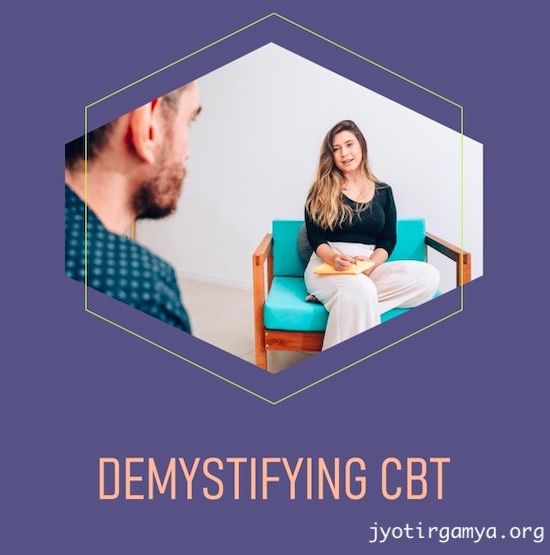Decoding the Differences: CBT vs. ACT vs. DBT Unveiled
Have you ever felt overwhelmed by a torrent of negative thoughts? Have you wrestled with emotions that seemed impossible to control? These experiences, though sometimes hidden, are surprisingly common. Studies reveal that millions face the challenges of anxiety, depression, and other mental health conditions. Yet, hope lies in the transformative power of therapy.

Mental health therapy provides a nurturing space for self-exploration and growth. Three prominent approaches, CBT, ACT, and DBT, offer unique tools for navigating life’s complexities. This journey will delve into each therapy, uncovering its core principles and guiding you toward a path of well-being.
Demystifying CBT: A Guide to Cognitive Behavioral Therapy
Ever wondered what goes on in the mind of a therapist? Well, CBT is one of their secret weapons! It’s a therapy that helps you understand how your thoughts, feelings, and actions are connected. Think of it as a toolbox filled with strategies to manage stress, anxiety, and even bad habits.

Here’s the basic idea:
- Your thoughts can be tricky: Sometimes, our brains lie to us, making us think things are worse than they are. CBT helps you spot these negative thoughts and replace them with more realistic and helpful ones.
- Actions speak louder than words: Changing your behavior can be as important as changing your thoughts. CBT teaches you new skills and ways to act, even when things get tough.
- Together is better: Therapy isn’t a solo mission. You and your therapist collaborate to identify your goals and develop a personalized plan.
CBT can help with lots of things, like:
- Feeling anxious or stressed all the time.
- Worrying too much about things you can’t control.
- Having trouble sleeping or eating.
- Feeling sad or hopeless.
- Dealing with complex relationships.
It’s like a journey of self-discovery, except you have a map and a guide to help you along the way. Think of your therapist as your personal Sherpa, leading you through the mountains of your emotions and guiding you toward the peak of well-being.
CBT isn’t just a therapy; it’s a way of life. The skills you learn can help you navigate life’s challenges and build resilience, even when things get messy. So, if you’re looking for a way to feel better and live your best life, try CBT. You might be surprised at what you can achieve!
Unraveling ACT: A Journey of Acceptance and Values-Driven Living
Imagine a life where you can embrace your emotions, stay true to your values, and live meaningfully, even amidst challenges. This is the promise of ACT (Acceptance and Commitment Therapy), a unique approach that empowers individuals to navigate life’s complexities with greater flexibility and well-being.

At the heart of ACT lies the fundamental principle of mindfulness: observing your thoughts and feelings without judgment, allowing them to come and go without becoming entangled in their narratives. This practice cultivates a sense of inner spaciousness and clarity, enabling you to respond to situations consciously rather than being driven by automatic reactions.
But ACT goes beyond mere acceptance. It challenges us to identify our core values, those guiding principles that define us, and what matters most to us. We create a sense of purpose and direction by aligning our actions with these values, even when facing difficulties.
Whether struggling with anxiety, depression, or simply seeking personal growth, ACT offers a versatile toolbox of strategies. From cognitive defusion techniques that help detach from unhelpful thoughts to commitment and action exercises that propel you towards your goals, ACT empowers you to take charge of your life and create meaningful change.
The roots of ACT can be traced back to the early 1980s, with the work of Steven C. Hayes and other pioneering researchers. Drawing inspiration from various disciplines, including mindfulness meditation and behavior analysis, they developed a robust framework for understanding and addressing human suffering.
The practice of mindfulness is more than just a theoretical concept in ACT. It is actively woven into the therapeutic process, with techniques like mindful breathing and observation used to cultivate present-moment awareness and non-judgmental acceptance.
Moreover, ACT emphasizes the importance of a collaborative therapeutic relationship. The therapist acts as a guide and companion, fostering a safe space for exploration and growth. This bond of trust and mutual respect is vital for facilitating self-discovery and unlocking the transformative potential of ACT.
ACT paves the way for a life of greater fulfillment and well-being through acceptance, mindfulness, and values-driven action. As you embark on this journey, remember that your challenges are not roadblocks but growth opportunities. With each step, you move closer to a life that aligns with your deepest values and authentic self.
Exploring DBT: Mastering the Art of Emotional Regulation
Have you ever felt overwhelmed by emotions? Do you wish you had a better toolkit for navigating life’s ups and downs? Dialectical Behavior Therapy (DBT) can be your guide. This evidence-based therapy focuses on equipping individuals with skills to manage their emotions effectively, fostering greater well-being and resilience.

At the core of DBT lies the concept of emotional regulation. This involves understanding your emotions, accepting their presence without judgment, and developing healthy strategies to cope with them. DBT teaches you to observe your emotions without getting swept away by them, empowering you to respond rather than react.
The four pillars of DBT form the foundation for this emotional mastery:
- Mindfulness: Cultivating present-moment awareness through techniques like meditation and mindful breathing.
- Distress Tolerance: Learning healthy ways to tolerate painful emotions without engaging in harmful behaviors.
- Emotion Regulation: Developing skills to identify, understand, and modify your emotional responses.
- Interpersonal Effectiveness: Communicating effectively and building healthy relationships.
These four pillars are interwoven and work together to create a comprehensive approach to emotional well-being. DBT offers a potent toolbox for individuals struggling with conditions such as borderline personality disorder, depression, anxiety, and substance use.
However, DBT is not a one-size-fits-all solution. Therapists tailor the approach to each individual’s unique needs and challenges. This flexible and adaptive nature allows DBT to be effective in diverse situations.
The journey of DBT began in the 1970s with Marsha Linehan’s groundbreaking work. Initially developed to treat borderline personality disorder, DBT has evolved to address various mental health challenges. Its effectiveness has been confirmed in numerous research studies, cementing its position as a leading therapeutic approach.
Trust and non-judgmental acceptance are cornerstones of the client-therapist relationship in DBT. This safe and supportive environment allows individuals to explore their emotions and vulnerabilities without fear of criticism. The therapist guides and coaches, empowering clients to develop self-compassion and self-efficacy.
By embracing the principles of DBT, you can embark on a journey of emotional mastery. You’ll learn to navigate life’s challenges with greater clarity and resilience, ultimately creating a more fulfilling and meaningful life.
Comparative Analysis: Dissecting the Nuances
Navigating the world of therapy can feel like deciphering a complex code. CBT, ACT, and DBT are just a few acronyms you might encounter, each promising a path toward greater well-being. But with so many options available, it’s natural to wonder: What sets these therapies apart?
Unique Aspects
Just like fingerprints, each therapy has its distinctive characteristics. Here’s a glimpse into what makes them unique:
- CBT: This therapy emphasizes identifying and modifying negative thought patterns that contribute to emotional distress. Think of it as rewiring your brain to adopt more helpful perspectives.
- ACT: This approach encourages embracing your emotions without judgment while aligning your actions with your core values. Imagine stepping back from the storm of emotions and choosing how to respond based on what matters most.
- DBT: This therapy equips you with a comprehensive toolbox for emotional regulation. Learn to manage your emotions effectively through mindfulness, distress tolerance, and interpersonal effectiveness.
Similarities and Contrasts
While their focuses may differ, these therapies share some common ground:
Similarities:
- Client-centered approach: All three therapies emphasize building a solid and supportive relationship between therapist and client.
- Focus on present-moment awareness: Mindfulness practices play a vital role in each therapy, helping individuals become more aware of their thoughts, feelings, and sensations.
- Emphasis on skill development: Each therapy offers practical tools and strategies individuals can use to manage their mental health.
Contrasts:
- Primary focus: CBT focuses on changing thoughts and behaviors, while ACT emphasizes acceptance and values-driven action. DBT, on the other hand, prioritizes emotional regulation skills.
- Structure: CBT typically follows a more structured format with specific goals and interventions, while ACT and DBT offer a more flexible approach.
- Target population: CBT is often used to treat anxiety and depression, while ACT and DBT are frequently used for more complex conditions like borderline personality disorder.
Scenario-Based Comparison
Imagine two individuals facing different challenges:
- Sarah struggles with persistent anxiety. She constantly worries about the future and feels overwhelmed by negative thoughts. CBT might be a good fit for her, helping her identify and modify these unhelpful thought patterns.
- John suffers from chronic depression and has difficulty expressing his emotions. He often feels isolated and disconnected from others. DBT could give him the tools to manage his emotions more effectively and build healthier relationships.
Therapeutic Integration
The beauty of these therapies lies in their adaptability. They can be used independently or combined to create a personalized approach. Imagine integrating mindfulness practices from ACT with the cognitive restructuring techniques of CBT. This could be a powerful combination for someone struggling with both anxiety and negative thought patterns.
Ultimately, the best approach to therapy is the one that works best for you. By understanding the unique aspects of each therapy, analyzing their similarities and contrasts, and considering your specific needs, you can choose the path that leads you towards greater well-being and a more fulfilling life.
Practical Applications: Navigating Real-World Scenarios
Step out of the theory world and into the real-life applications of CBT, ACT, and DBT. Here’s how these therapies can empower individuals to navigate the complexities of daily life:
Real Life Scenarios
- Imagine Sarah, once crippled by anxiety, now confidently navigating life’s challenges. CBT helped her identify and modify negative thought patterns, replacing them with more realistic and empowering perspectives.
- **Once isolated and struggling to manage his emotions, John now shares open and fulfilling relationships.**DBT equipped him with the skills to navigate his emotional landscape and build healthier connections with others.
- Once consumed by negative self-talk, Maria now embraces her emotions and pursues her passions. ACT guided her towards self-acceptance and helped her align her actions with her core values, leading to a more fulfilling life.
Synergistic Benefits
Combining therapies can be like adding colors to a painting, creating a more vibrant experience.
For example:
- Imagine integrating CBT’s cognitive restructuring techniques with ACT’s mindfulness practices. This powerful combination can help individuals change their thoughts and observe them without judgment, leading to lasting positive outcomes.
- DBT’s emotional regulation skills can be combined with ACT’s values-driven approach for individuals struggling with complex challenges. This can empower them to manage difficult emotions while aligning their actions with what matters most.
Cultural Sensitivity
Just as fingerprints are unique, so are cultural backgrounds. Therapists must be sensitive to cultural factors influencing an individual’s therapy experience. This includes:
- Language barriers: Utilizing interpreters and culturally familiar language can create a more inclusive and welcoming environment.
- Cultural beliefs and values: Understanding an individual’s cultural background allows therapists to tailor their approach and interventions to be respectful and practical.
- Social norms: Different cultures have varying expectations and norms around mental health. Therapists should strive to understand these nuances to avoid misunderstandings and promote positive outcomes.
Duration and Expectations
Therapy is a challenging fix. It’s a journey of self-discovery and growth that takes time and effort. The duration of therapy can vary depending on individual needs and goals. However, it’s essential to set realistic expectations:
- CBT and ACT typically require shorter-term commitments, focusing on specific goals and interventions.
- DBT often requires a longer-term commitment, providing individuals with comprehensive skills for emotional regulation and healthy relationships.
- Regardless of the duration, remember that therapy is a process, not a destination. Progress happens in small steps, and each step is a win towards achieving your desired outcomes.
By understanding how these therapies can be applied in real-world scenarios, considering the potential benefits of combining approaches, embracing cultural sensitivity, and setting realistic expectations, you can embark on a personal journey of transformation with greater clarity and confidence.
Choosing the Right Therapy: A Personalized Journey
Finding the right therapy can feel like searching for a hidden treasure: a valuable tool that unlocks inner well-being and personal growth. But with so many options available, it’s natural to wonder: How do I choose the best therapy for me?
Guiding Factors
- Personal Needs and Goals: What are you hoping to achieve through therapy? Are you struggling with anxiety, depression, or a specific mental health condition? Identifying your needs and goals provides a clear direction for your therapeutic journey.
- Therapy Preferences: Consider your learning style and preferences. Do you respond better to structured approaches, like CBT, or prefer a more flexible and open-ended approach, like ACT?
- Cultural Considerations: Therapy should be sensitive to your cultural background and beliefs. Look for therapists who understand and respect your cultural identity.
Therapist Expertise
- Professional Guidance: Therapists are crucial in guiding you toward the right therapy. They can help you understand your options, assess your needs, and recommend the most suitable approach.
- Therapist-Client Relationship: You must find a therapist you feel comfortable with and trust. The therapeutic alliance creates a safe space for exploration and growth.
Personalization
- Unique Journey: Remember, there is no one-size-fits-all approach to therapy. What works for one person might not work for another. Trust your instincts and intuition when choosing a therapy that feels right for you.
- Flexibility and Adaptability: Be open to exploring different approaches and adjusting your therapy plan as needed. This flexibility allows you to find the most effective path to achieving your goals.
Potential Challenges and Limitations
- Commitment: Therapy requires time and effort. Be prepared for setbacks and challenges along the way.
- Cost and Access: Therapy can be expensive, and access to mental health services can be limited in some areas. Explore alternative options and resources to ensure your needs are met.
- Therapist Competency: Not all therapists are created equal. Research and choose a qualified therapist who is experienced and licensed.
Conclusion
This journey has unveiled the depths of CBT, ACT, and DBT, revealing their unique strengths and potential to empower individuals on their paths to well-being. Let’s recap the key takeaways:
- CBT: This therapy equips individuals with the tools to identify and modify negative thought patterns, fostering a more optimistic outlook and improved emotional regulation.
- ACT: This approach emphasizes accepting emotions without judgment and aligning actions with core values, leading to a sense of purpose and direction.
- DBT: This therapy offers a comprehensive toolkit for managing emotions, building healthy relationships, and coping with challenging situations.
While this exploration has provided valuable insights, remember that professional guidance remains crucial for navigating your healing journey. Therapists act as skilled guides, providing tailored support and interventions based on your unique needs and goals. Don’t hesitate to seek professional help when embarking on this transformative journey.
Additional Resources
Your journey doesn’t end here. Here are some reliable resources to further explore mental health and find additional support:
- National Alliance on Mental Illness (NAMI): https://www.nami.org/Home
- MentalHealth.gov: https://www.samhsa.gov/mental-health
- Anxiety and Depression Association of America (ADAA): https://adaa.org/
- The Jed Foundation: https://jedfoundation.org/
Healing is a Unique Journey
Remember, healing is not a linear path but a unique journey for each individual. Embrace the setbacks and challenges as opportunities for growth, and celebrate your successes along the way. With self-compassion, resilience, and the support of professionals and resources, you can transform your mental health and create a life filled with purpose and well-being.
So, take courage, embrace the path ahead, and embark on your healing journey. Remember, you are not alone in this.
By joining forces, we can create a world where mental health is openly discussed, stigma is eradicated, and everyone has access to the support they need to thrive. Take action today, share your voice, and become a champion for mental health awareness. Remember, you are not alone in this journey. Together, we can create a brighter future for mental well-being.
Related Articles
Sound Therapy for Learning and Pain
Play Therapy: A Powerful Tool for Mental Health
Mastering the Six Core Skills of ACT for Psychological Flexibility
How to Deal with Anxiety: Expert Advice and Techniques
Want to stay connected? Here’s our twitter.